
CHAPTER 18--ORGANIZATION STRUCTURE AND
CORPORATE GOVERNANCE
Student: ___________________________________________________________________________
2. The merger between Proctor & Gamble, maker of products like Tide, Crest, and Pampers, and Gillette, the



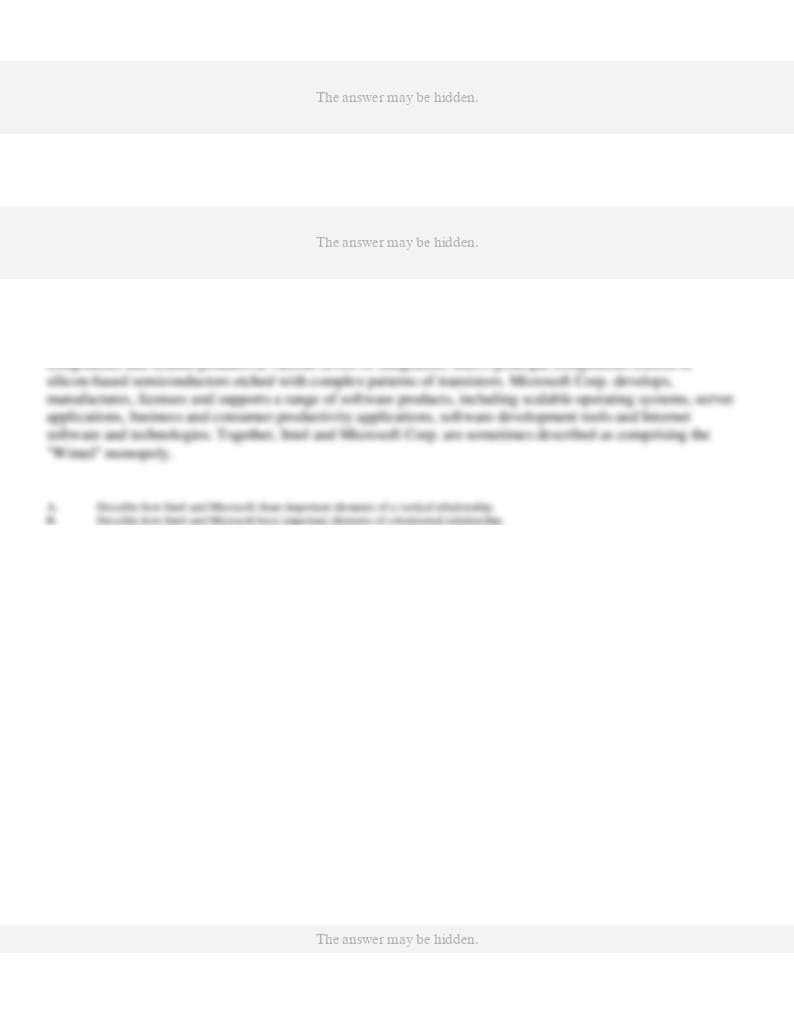
26. Horizontal and Vertical Relations. Intel Corp. designs, manufactures and markets microcomputer
27. Horizontal and Vertical Relations. America Online, Inc., is a provider of online services to consumers in
the United States. AOL offers subscribers a wide variety of services, including electronic mail, conferencing,
news, sports, weather, stock quotes, software, computing support and online classes. These services can be
accessed from a range of personal computers using AOL's proprietary software. Microsoft Corp. develops,
manufactures, licenses, sells, and supports a wide range of software products, including operating systems for
personal computers and servers; server applications for client/server environments, business and consumer
productivity applications; interactive media programs; and Internet platform and development tools. Microsoft
also offers online services, sells personal computer books and input devices, and researches and develops
advanced technology software products.
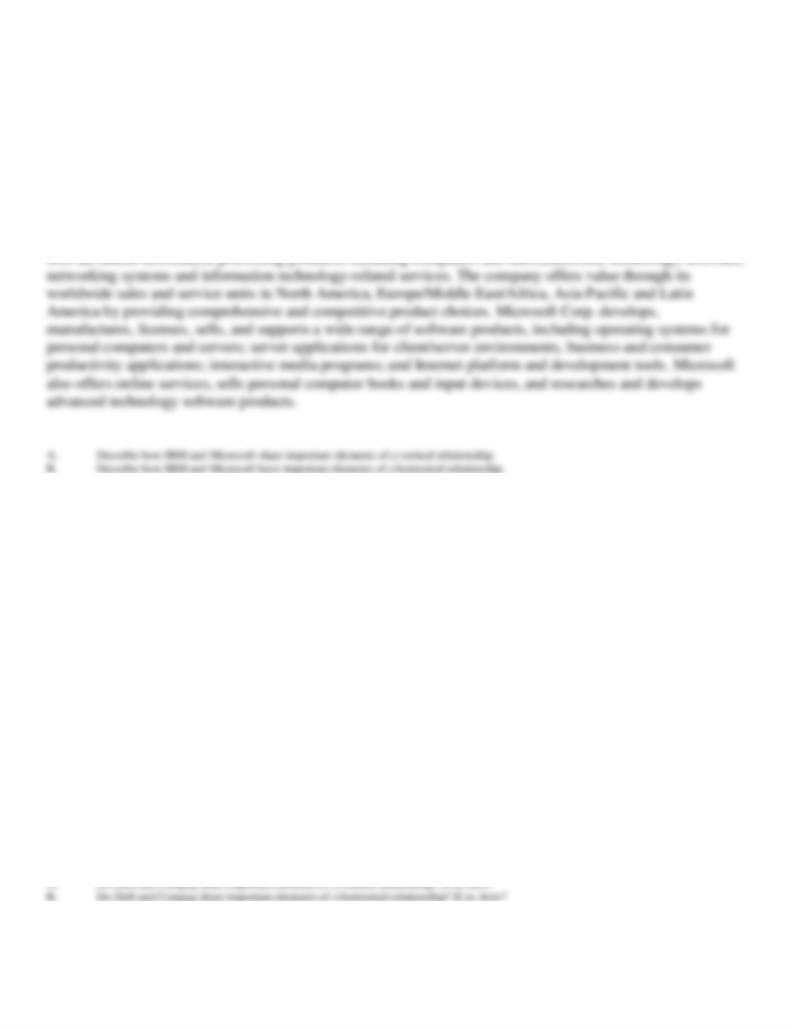
28. Horizontal and Vertical Relations. International Business Machines (IBM) develops, manufactures and
29. Horizontal and Vertical Relations. Dell Computer Corp. designs, develops, manufactures, markets,
services and supports a wide range of computer systems, including desktops, notebooks and network servers,
and also markets software, peripherals and service and support programs. They are the world's leading direct
computer systems company and one of the top five computer vendors in the world. Compaq Computer Corp.
designs, develops, manufactures, and markets a wide range of personal computing products, including desktop
personal computers, portable computers, PC servers and peripheral products that store and manage data in
network environments. The company markets its products primarily to business, home, government, and
education customers. Compaq operates in one principal industry segment across geographically diverse
markets.

30. Horizontal and Vertical Relations. Barnes & Noble, Inc. is one of the world's largest booksellers. The
company's principal business is the retail sale of trade books, generally hardcover and paperback consumer
titles, excluding educational textbooks and specialized religious titles, mass market paperbacks, such as
mystery, romance, science fiction and other popular fiction, children's books, off-price bargain books and
magazines. Borders Group, Inc. is one of the largest operators of book superstores and mall-based bookstores in
the world based upon both sales and number of stores. Borders is a premier operator of book and music
superstores, offering customers selection and service that the company believes to be superior to other book
superstore operators. Each Borders superstore offers customers a vast assortment of books, customer service,
value pricing and an inviting and comfortable environment designed to encourage browsing.
31. Nature of the Firm. Dell Computer Corp. designs, develops, manufactures, markets, services and supports
a wide range of computer systems, including desktops, notebooks and network servers, and also markets
software, peripherals and service and support programs. They are the world's leading direct computer systems
company and one of the top five computer vendors in the world.
A.
Critics of Dell argue that the company is "merely" a retailer bringing together computer manufacturers and customers. Would Ronald

32. Nature of the Firm. Amazon.com is a leading online retailer of books. The company also sells CDs,
videotapes, audiotapes and other products over the Internet, and on proprietary online services like America
Online. Amazon.com has a limited operating history upon which to base an evaluation of its business and
prospects. The company's prospects must be considered in light of the risks, expenses and difficulties frequently
encountered by companies in their early stage of development, particularly companies in new and rapidly
evolving markets such as online commerce.
A.
Critics of Amazon.com allege that the company is "merely" an information processing device for bringing together book wholesalers
33. Transactions Costs. Centex Corp. is one of the nation's largest home builders, building and delivering,
through its subsidiary Centex Homes, over 10,000 homes per year. Centex's housing operations currently
involve the construction and sale of single-family and multi-family homes in over 50 different markets
nationwide. These activities also include the purchase and development of land.
A.
Use transactions costs to explain the existence of firms like Centex.
B.
When will less formal contracting arrangements supplant the need for a formal corporate structure?

34. Transactions Costs. Humana, Inc., offers managed health care products which integrate management with
the delivery of health care services through a network of providers, who in their delivery of quality medical
services, may share financial risk or who have incentives to deliver cost-effective medical services. It also offers
administrative services products including group life, dental, disability income, workers' compensation, and
pharmacy management services.
35. Virtual Corporation. Cendant Corporation provides travel and real estate services primarily in the United
States and the United Kingdom. It operates in six segments: Real Estate Franchise and Operations, Hospitality
Services, Travel Distribution Services, Vehicle Services, Mortgage Services, and Marketing Services. The Real
Estate Franchise and Operations segment franchises the real estate brokerage businesses, provides real estate
brokerage services, and assists in employee relocations through Cendant Mobility. Cendants's Hospitality
Services segment operates eight lodging franchise systems; facilitates the sale, exchange, and development of
time-share vacation ownership interests; and markets and manages vacation rental properties. The Travel
Distribution Services segment provides travel content and services to consumers, travel agencies, corporations,
and suppliers of travel products and services. The Vehicle Services segment operates and franchises its Avis
and Budget vehicle rental businesses. Mortgage Services provides home buyers with mortgage lending services
and title, appraisal, and closing services. And finally, the Marketing Services segment provides membership,
loyalty, and insurance-based products and services to financial institutions and other partners.
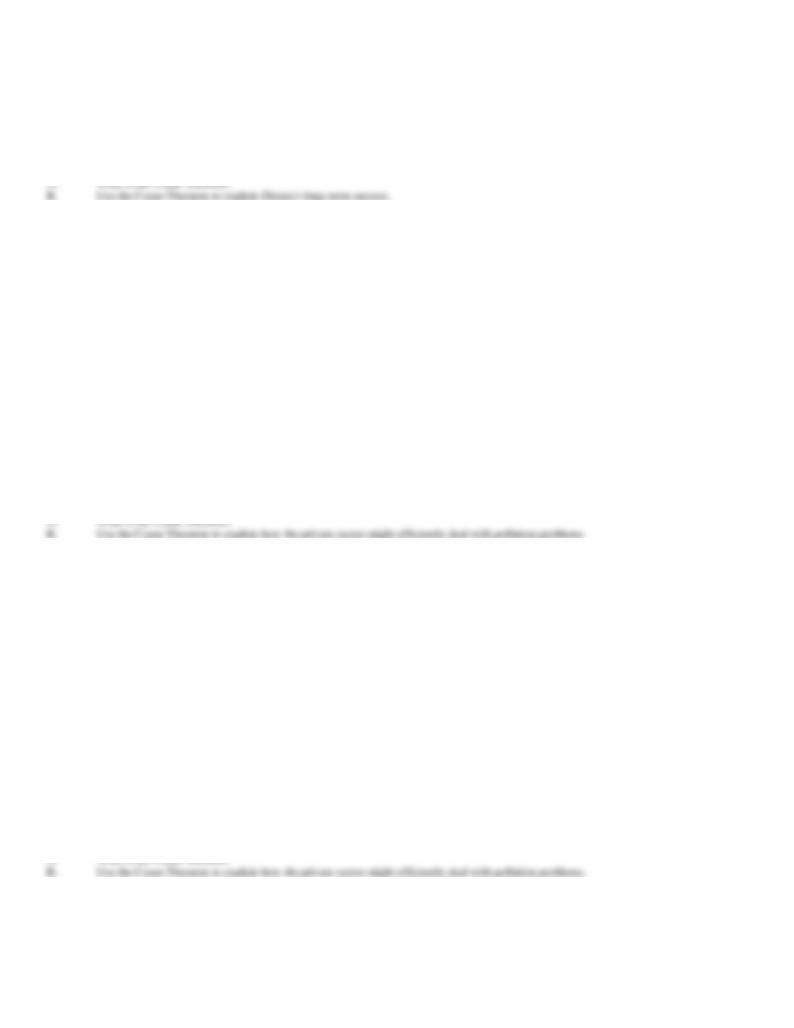
36. Virtual Corporation. The Walt Disney Company is a diversified, international family entertainment and
media juggernaut whose operations include world-famous theme parks and resorts. The company also includes
a filmed entertainment division, specializing in motion pictures and television shows, and home video products.
Disney also offers records, consumer products, a cruise line, radio and television stations, broadcast and cable
networks, publishing activities and professional sports enterprises.
37. Coase Theorem. One of the traditional arguments in favor of government intervention in the market
economy is that unregulated market activity can sometimes lead to failures, like pollution. Critics of
government failures to deal with pollution problems effectively argue that there exist private-market solutions to
the pollution problem.
38. Coase Theorem. Suppose a power plant reduced recreational opportunities by fouling a nearby river. A
natural result would be for local environmentalists and consumers to petition local authorities for regulations
outlawing or severely limiting such anti-social behavior. On the other hand, others might argue that there exist
efficient and effective private-market solutions to such pollution problems.

39. Agency Problem. In 2005, Qwest Communications International Inc. ended its pursuit of MCI Inc. While
the Denver-based company had worked hard to win Virginia-based MCI, Qwest walk away from a bidding war
with Verizon Communications Inc., a large New York-based phone company, when Qwest's increasingly
expensive effort seemed futile. Ending a furious three-month bidding war, long-distance phone titan MCI turned
down a $9.74 billion takeover offer from Qwest, a local and long-distance phone company, in favor of a $8.44
billion offer from the more financially secure Verizon. At the time, some of MCI's largest shareholders
criticized MCI's board for taking the lower bid and urged Qwest to persist, but Qwest declined.
40. Agency Problem. In 2005, former WorldCom Inc. Chief Executive Bernard J. Ebbers was found guilty on
charges of conspiracy, securities fraud and making false filings with the Securities and Exchange Commission
in connection with what authorities have described as the largest accounting fraud in U.S. history. He could
spend the rest of his life in jail.

41. Excessive Risk Taking. In 2005, The Wall Street Journal reported that two founders of Amerindo
Investment Advisors Inc., a money-management firm that makes outsized bets in technology stocks, were
charged with stealing millions of dollars from investors to make charitable donations and buy thoroughbred
racehorses. Alberto Vilar and Gary Tanaka were charged with fraud and arrested by U.S. Postal inspectors.
Vilar and Tanaka made names for themselves by betting big on biotechnology and technology stocks. Their
fund was an early investor in Web portal Yahoo Inc. and generated huge returns for its early investors,
including many institutions and high net-worth individuals. The duo later created a mutual fund, which in 1999
reported a 249% return to investors.
After amassing a huge fortune in the late 1990s, Vilar pledged hundreds of millions of dollars to charities,
including New York's Metropolitan Opera, Washington's Kennedy Center and New York University. Hurt by
the bursting of the technology bubble and an exodus of investors, the firm's assets under management dropped
from $8 billion in March 2000 to about $1.5 billion in 2005.
42. Other Peoples' Money Problem. In 2008, France's Société Générale SA said that a 31-year-old trader
named Jérôme Kerviel had cost the bank €4.9 billion (equivalent to $7.2 billion) by making huge unauthorized
trades. Société Générale's loss dwarfed the $1.3 billion Nick Leeson cost Britain's Barings Bank in 1995, and
forced Société Générale to seek a capital infusion of as much as €5.5 billion ($8 billion). Société Générale's loss
was only one of many huge write offs tied to a general breakdown in risk controls at gigantic international
financial institutions. In 2007-08, giant financial institutions around the world lost billions of dollars on
complex financial instruments tied to subprime mortgages and various poorly designed trading strategies. Such
losses had important and far-reaching economic ramifications. For example, Société Générale's frantic efforts to
unwind Kerviel's unauthorized trades over a 72-hour period rattled global financial markets, and spurred
dramatic moves by the Federal Reserve Board's Ben Bernanke to cut U.S. interest rates and head off a deep
economic recession.
A.
Explain this Société Générale bank episode as a manifestation of the "other peoples' money" problem.
B.
How could it have been avoided?
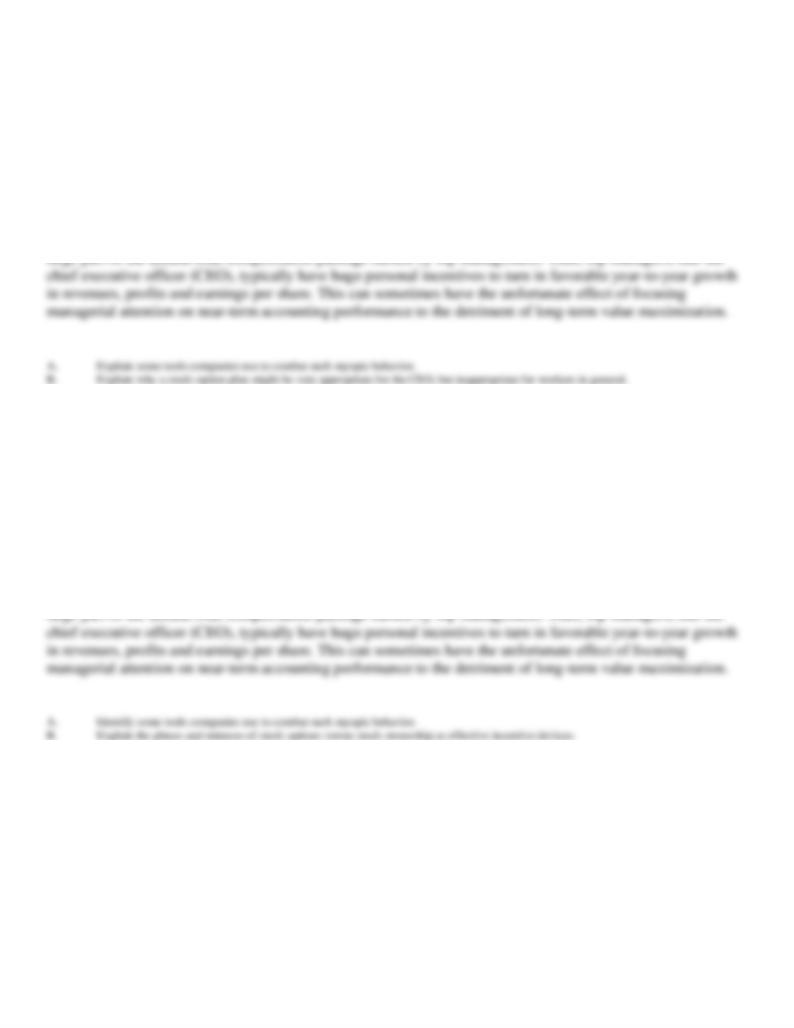
43. Incentive Compensation. Salary and bonus payments tied to short-term performance often constitute a
44. Incentive Compensation. Salary and bonus payments tied to short-term performance often constitute a
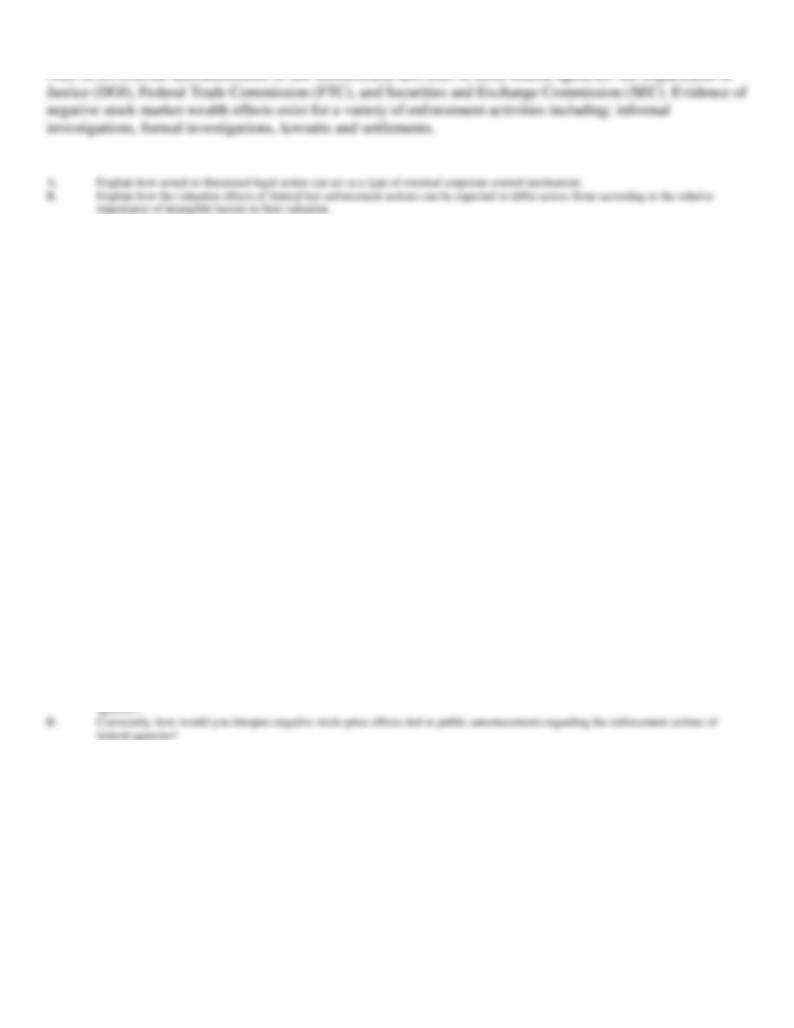
45. Corporate Governance. Empirical studies show a negative stock-price reaction for firms mentioned in
46. Corporate Governance. In a fully informed stock market, news regarding the enforcement of federal laws
against publicly traded firms would have no effect on target firm stock prices. A "rational expectations
hypothesis" predicts that investors would be unaffected by announcements concerning the enforcement actions
of federal agencies because current stock prices accurately reflect discounted future cash flows based upon all
relevant information. An absence of announcement effects tied to federal law enforcement actions would
suggest that the market is fully aware of illegal activity, the probability of getting caught, and the potential
sanctions tied to detection and conviction. Future cash flows lost following federal law enforcement actions can
include the costs of sacrificing illegal advantages over competitors, investigation expenditures, litigation
expenses, and lost reputational capital. An absence of abnormal returns tied to federal law enforcement actions
does not mean that there is no cost to being caught; it simply implies that the market correctly anticipates the
magnitude and probability of such costs. Here it is important to recognize that the term "caught" does not
necessarily imply guilt as well. Under the rational expectations hypothesis, market participants also know the
probability of innocent firms being investigated or sued.
A.
How would you interpret positive stock-price effects tied to public announcements regarding the enforcement actions of federal
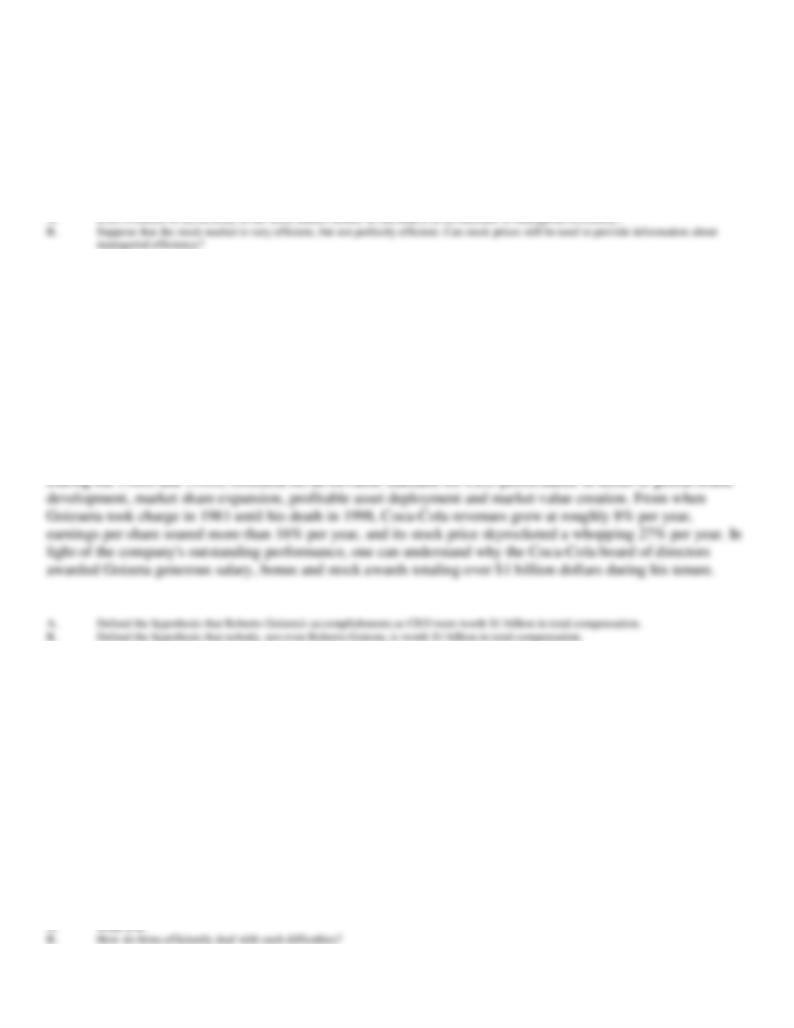
47. Stock-market Indicators of Efficiency. According to the Efficient Market Hypothesis, current stock prices
reflect all relevant risk and return information. This implies that near-term stock price changes are random and
independent. In a rational pricing environment, investing in the stock market is a "fair game" where the
expected excess return for each security is zero. Taken literally, this means that every stock at every point in
time is an equally good buy (or sell). Within this context, the stock market provides a useful context within
which to evaluate managerial decisions. "Good" decisions boost share prices, and "bad" decisions cause share
prices to fall.
48. Executive Compensation. Roberto Goizueta did a superb job as head of soft-drink juggernaut Coca-Cola.
49. End-of-game Problem. One of the most vexing problems facing boards of directors and stockholders is the
so-called "end-of-game" problem.

50. Organization Design. An effective organization design is one that allocates decision authority to that
person or team of persons best able to perform a given task or influence a particular outcome. Decision
authority allows individual employees to determine how and when to best deploy the productive resources and
valuable information at their disposal. Of course, decision authority confers responsibility. It is thus imperative
to monitor and evaluate performance. Managers and all employees must be held accountable for outcomes tied
to individual decisions. Accountability can only be measured in terms of the tangible and intangible rewards
derived from productive activity, and in terms of the penalties or sanctions tied to unproductive behavior. To
minimize the costs of unproductive conflict with the firm, it is essential that the design of the organization
effectively allocate decision making authority.

CHAPTER 18--ORGANIZATION STRUCTURE AND
CORPORATE GOVERNANCE Key
2. The merger between Proctor & Gamble, maker of products like Tide, Crest, and Pampers, and Gillette, the




26. Horizontal and Vertical Relations. Intel Corp. designs, manufactures and markets microcomputer
components and related products at various levels of integration. Intel's principal components consist of
silicon-based semiconductors etched with complex patterns of transistors. Microsoft Corp. develops,
manufactures, licenses and supports a range of software products, including scalable operating systems, server
applications, business and consumer productivity applications, software development tools and Internet
software and technologies. Together, Intel and Microsoft Corp. are sometimes described as comprising the
"Wintel" monopoly.
A.
Describe how Intel and Microsoft share important elements of a vertical relationship.
B.
Describe how Intel and Microsoft have important elements of a horizontal relationship.
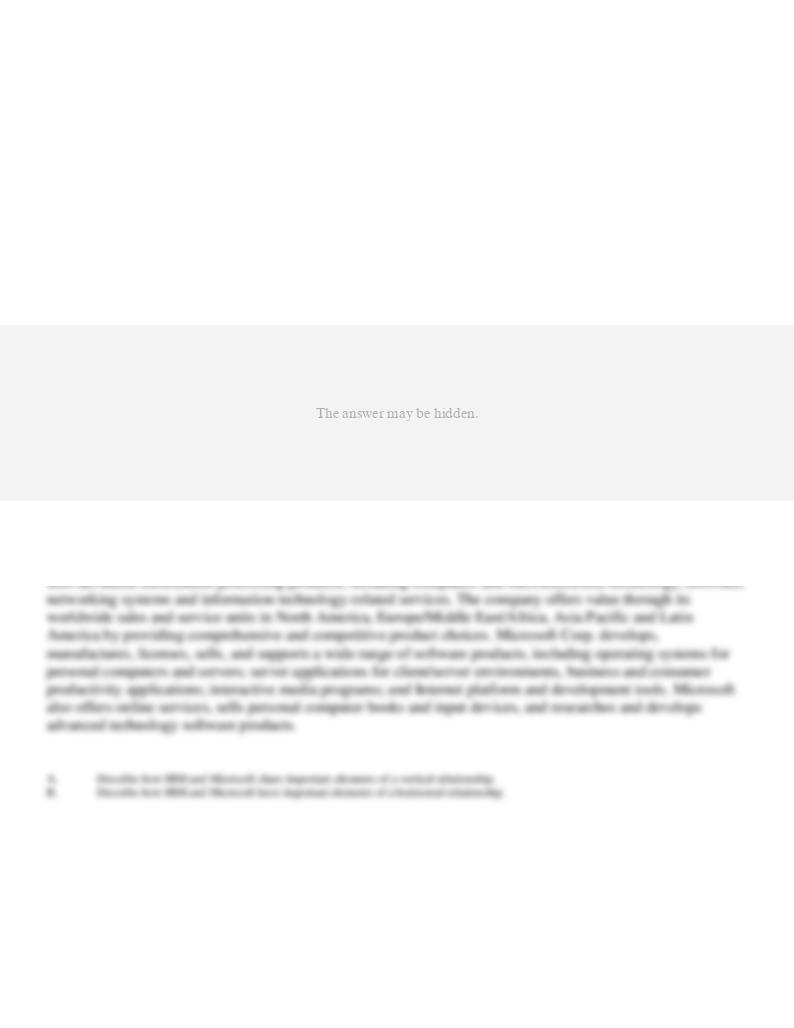
27. Horizontal and Vertical Relations. America Online, Inc., is a provider of online services to consumers in
the United States. AOL offers subscribers a wide variety of services, including electronic mail, conferencing,
news, sports, weather, stock quotes, software, computing support and online classes. These services can be
accessed from a range of personal computers using AOL's proprietary software. Microsoft Corp. develops,
manufactures, licenses, sells, and supports a wide range of software products, including operating systems for
personal computers and servers; server applications for client/server environments, business and consumer
productivity applications; interactive media programs; and Internet platform and development tools. Microsoft
also offers online services, sells personal computer books and input devices, and researches and develops
advanced technology software products.
A.
Describe how AOL and Microsoft share important elements of a vertical relationship.
B.
Describe how AOL and Microsoft have important elements of a horizontal relationship.
28. Horizontal and Vertical Relations. International Business Machines (IBM) develops, manufactures and

29. Horizontal and Vertical Relations. Dell Computer Corp. designs, develops, manufactures, markets,
services and supports a wide range of computer systems, including desktops, notebooks and network servers,
and also markets software, peripherals and service and support programs. They are the world's leading direct
computer systems company and one of the top five computer vendors in the world. Compaq Computer Corp.
designs, develops, manufactures, and markets a wide range of personal computing products, including desktop
personal computers, portable computers, PC servers and peripheral products that store and manage data in
network environments. The company markets its products primarily to business, home, government, and
education customers. Compaq operates in one principal industry segment across geographically diverse
markets.
A.
Do Dell and Compaq share important elements of a vertical relationship? If so, how?
B.
Do Dell and Compaq share important elements of a horizontal relationship? If so, how?
30. Horizontal and Vertical Relations. Barnes & Noble, Inc. is one of the world's largest booksellers. The
company's principal business is the retail sale of trade books, generally hardcover and paperback consumer
titles, excluding educational textbooks and specialized religious titles, mass market paperbacks, such as
mystery, romance, science fiction and other popular fiction, children's books, off-price bargain books and
magazines. Borders Group, Inc. is one of the largest operators of book superstores and mall-based bookstores in
the world based upon both sales and number of stores. Borders is a premier operator of book and music
superstores, offering customers selection and service that the company believes to be superior to other book
superstore operators. Each Borders superstore offers customers a vast assortment of books, customer service,
value pricing and an inviting and comfortable environment designed to encourage browsing.
A.
Do Barnes & Noble and Borders share important elements of a vertical relationship? If so, how?
B.
Do Barnes & Noble and Borders share important elements of a horizontal relationship? If so, how?
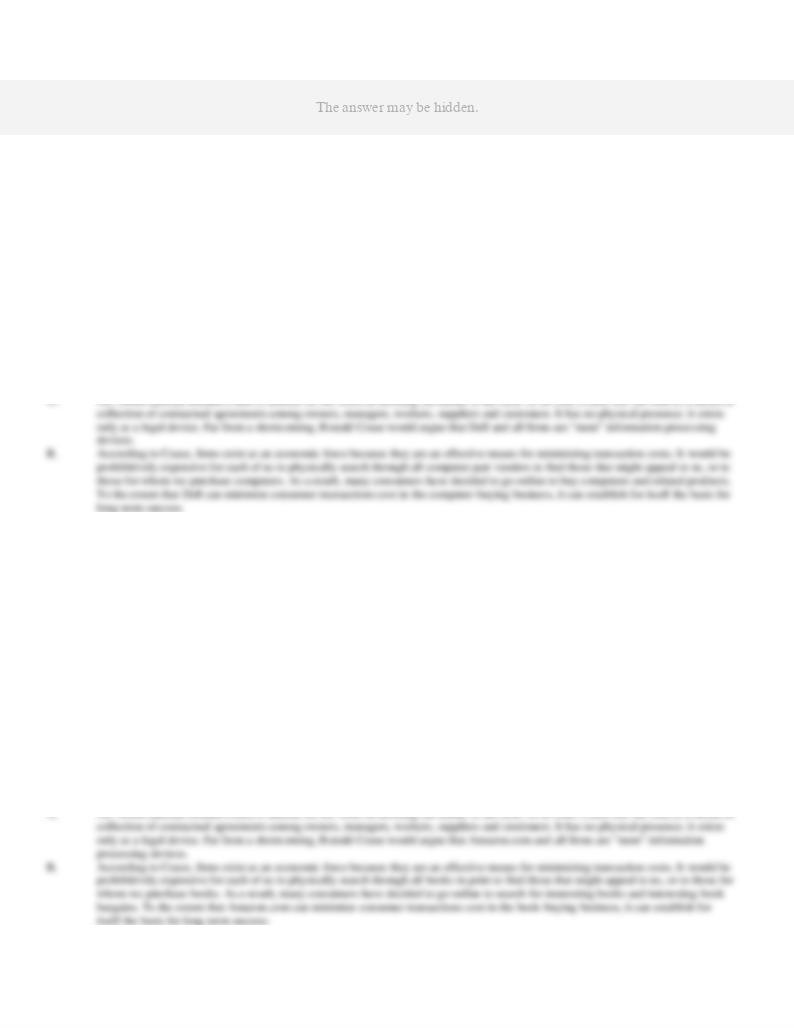
31. Nature of the Firm. Dell Computer Corp. designs, develops, manufactures, markets, services and supports
a wide range of computer systems, including desktops, notebooks and network servers, and also markets
software, peripherals and service and support programs. They are the world's leading direct computer systems
company and one of the top five computer vendors in the world.
A.
Critics of Dell argue that the company is "merely" a retailer bringing together computer manufacturers and customers. Would Ronald
Coase agree that this is a shortcoming of Dell?
B.
In what way must Dell be efficient if it is to enjoy long-term success?
32. Nature of the Firm. Amazon.com is a leading online retailer of books. The company also sells CDs,
videotapes, audiotapes and other products over the Internet, and on proprietary online services like America
Online. Amazon.com has a limited operating history upon which to base an evaluation of its business and
prospects. The company's prospects must be considered in light of the risks, expenses and difficulties frequently
encountered by companies in their early stage of development, particularly companies in new and rapidly
evolving markets such as online commerce.
A.
Critics of Amazon.com allege that the company is "merely" an information processing device for bringing together book wholesalers
and customers. Would Ronald Coase agree that this is a shortcoming of Amazon.com?
B.
In what way must Amazon.com be efficient if it is to enjoy long-term success?
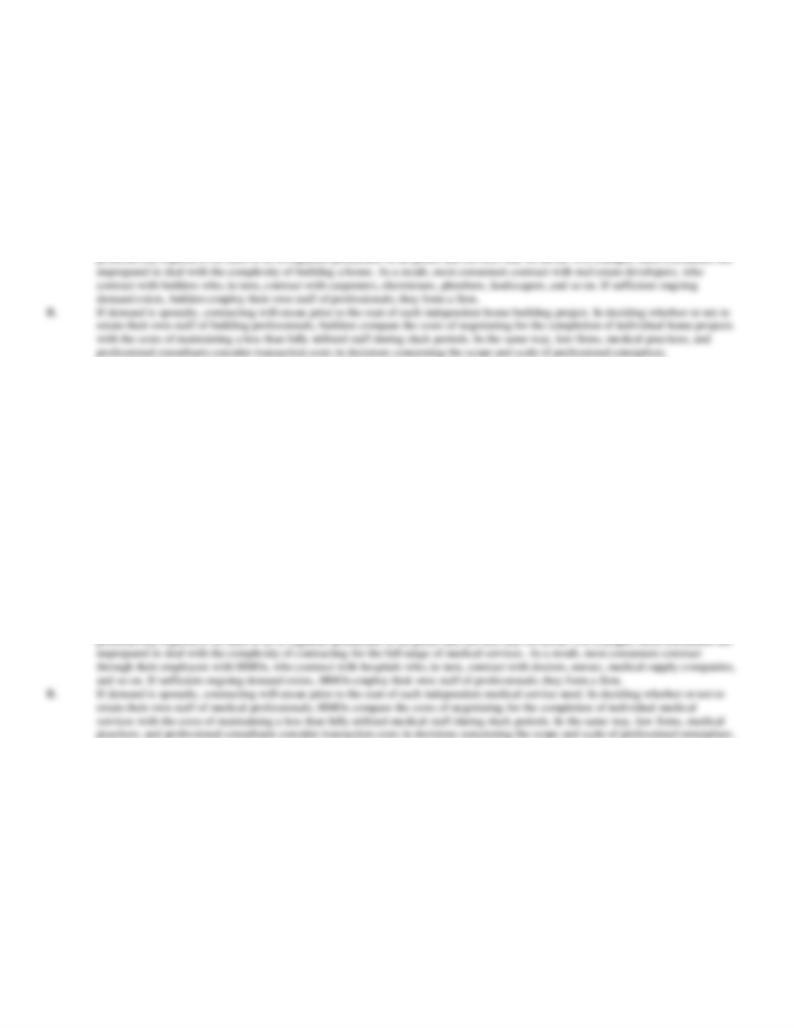
33. Transactions Costs. Centex Corp. is one of the nation's largest home builders, building and delivering,
through its subsidiary Centex Homes, over 10,000 homes per year. Centex's housing operations currently
involve the construction and sale of single-family and multi-family homes in over 50 different markets
nationwide. These activities also include the purchase and development of land.
A.
Use transactions costs to explain the existence of firms like Centex.
B.
When will less formal contracting arrangements supplant the need for a formal corporate structure?
A.
According to Coase, firms exist as an economic force because they are an effective means for minimizing transaction costs. It would be
34. Transactions Costs. Humana, Inc., offers managed health care products which integrate management with
the delivery of health care services through a network of providers, who in their delivery of quality medical
services, may share financial risk or who have incentives to deliver cost-effective medical services. It also offers
administrative services products including group life, dental, disability income, workers' compensation, and
pharmacy management services.
A.
Use transactions costs to explain the existence of HMOs like Humana.
B.
When will less formal contracting arrangements supplant the need for a formal corporate structure?
A.
According to Coase, firms exist as an economic force because they are an effective means for minimizing transaction costs. It would be

35. Virtual Corporation. Cendant Corporation provides travel and real estate services primarily in the United
States and the United Kingdom. It operates in six segments: Real Estate Franchise and Operations, Hospitality
Services, Travel Distribution Services, Vehicle Services, Mortgage Services, and Marketing Services. The Real
Estate Franchise and Operations segment franchises the real estate brokerage businesses, provides real estate
brokerage services, and assists in employee relocations through Cendant Mobility. Cendants's Hospitality
Services segment operates eight lodging franchise systems; facilitates the sale, exchange, and development of
time-share vacation ownership interests; and markets and manages vacation rental properties. The Travel
Distribution Services segment provides travel content and services to consumers, travel agencies, corporations,
and suppliers of travel products and services. The Vehicle Services segment operates and franchises its Avis
and Budget vehicle rental businesses. Mortgage Services provides home buyers with mortgage lending services
and title, appraisal, and closing services. And finally, the Marketing Services segment provides membership,
loyalty, and insurance-based products and services to financial institutions and other partners.
36. Virtual Corporation. The Walt Disney Company is a diversified, international family entertainment and
media juggernaut whose operations include world-famous theme parks and resorts. The company also includes
a filmed entertainment division, specializing in motion pictures and television shows, and home video products.
Disney also offers records, consumer products, a cruise line, radio and television stations, broadcast and cable
networks, publishing activities and professional sports enterprises.
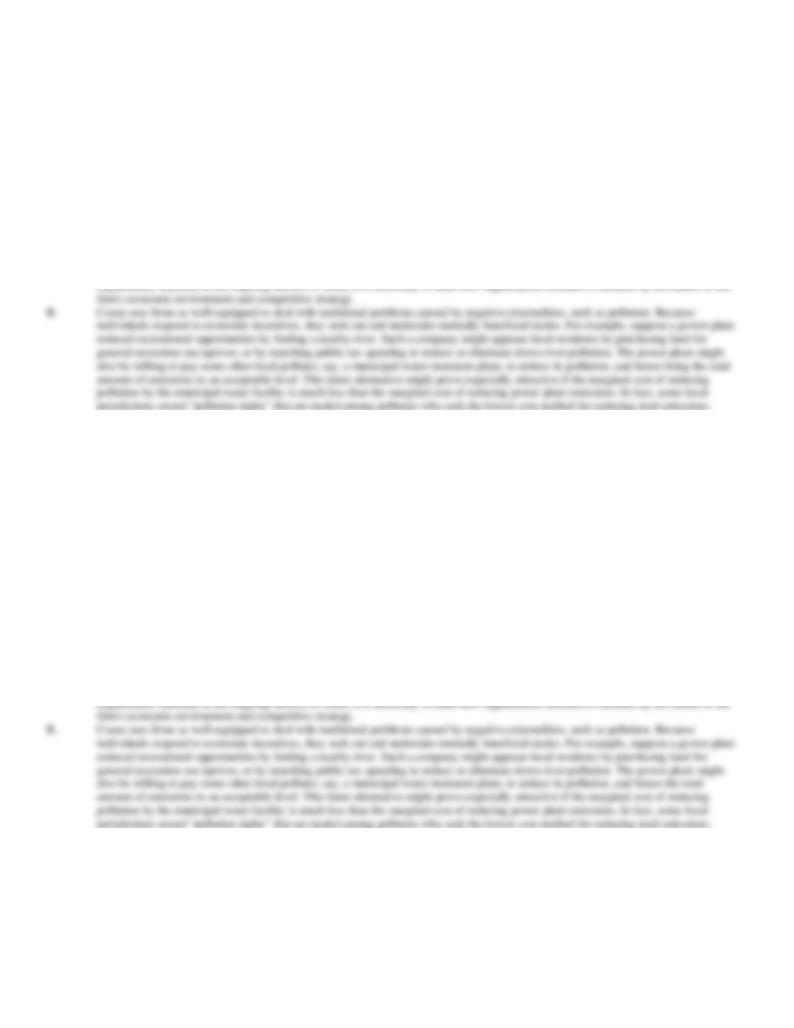
37. Coase Theorem. One of the traditional arguments in favor of government intervention in the market
economy is that unregulated market activity can sometimes lead to failures, like pollution. Critics of
government failures to deal with pollution problems effectively argue that there exist private-market solutions to
the pollution problem.
A.
What is the Coase Theorem?
B.
Use the Coase Theorem to explain how the private sector might efficiently deal with pollution problems.
A.
According to what is now referred to as the Coase Theorem, resource allocation will be efficient so long as transaction costs remain low
and property rights can be freely assigned and exchanged. The transaction cost concept is important in managerial economics because it
provides the context necessary for considering the economic significance of organization structure. To understand the importance of
38. Coase Theorem. Suppose a power plant reduced recreational opportunities by fouling a nearby river. A
natural result would be for local environmentalists and consumers to petition local authorities for regulations
outlawing or severely limiting such anti-social behavior. On the other hand, others might argue that there exist
efficient and effective private-market solutions to such pollution problems.
A.
What is the Coase Theorem?
B.
Use the Coase Theorem to explain how the private sector might efficiently deal with pollution problems.
A.
According to what is now referred to as the Coase Theorem, resource allocation will be efficient so long as transaction costs remain low
and property rights can be freely assigned and exchanged. The transaction cost concept is important in managerial economics because it
provides the context necessary for considering the economic significance of organization structure. To understand the importance of

39. Agency Problem. In 2005, Qwest Communications International Inc. ended its pursuit of MCI Inc. While
the Denver-based company had worked hard to win Virginia-based MCI, Qwest walk away from a bidding war
with Verizon Communications Inc., a large New York-based phone company, when Qwest's increasingly
expensive effort seemed futile. Ending a furious three-month bidding war, long-distance phone titan MCI turned
down a $9.74 billion takeover offer from Qwest, a local and long-distance phone company, in favor of a $8.44
billion offer from the more financially secure Verizon. At the time, some of MCI's largest shareholders
criticized MCI's board for taking the lower bid and urged Qwest to persist, but Qwest declined.
A.
What is the potential agency problem at Qwest?
B.
What is the source of agency problems within Qwest and similar companies?
A.
Given their ownership position, stockholders are the principals of the firm. Managers and other employees without any ownership
40. Agency Problem. In 2005, former WorldCom Inc. Chief Executive Bernard J. Ebbers was found guilty on
charges of conspiracy, securities fraud and making false filings with the Securities and Exchange Commission
in connection with what authorities have described as the largest accounting fraud in U.S. history. He could
spend the rest of his life in jail.
A.
What is the firm's potential agency problem?
B.
What are agency costs within this firm?
A.
Given their ownership position, stockholders are the principals of the firm. Managers and other employees without any ownership
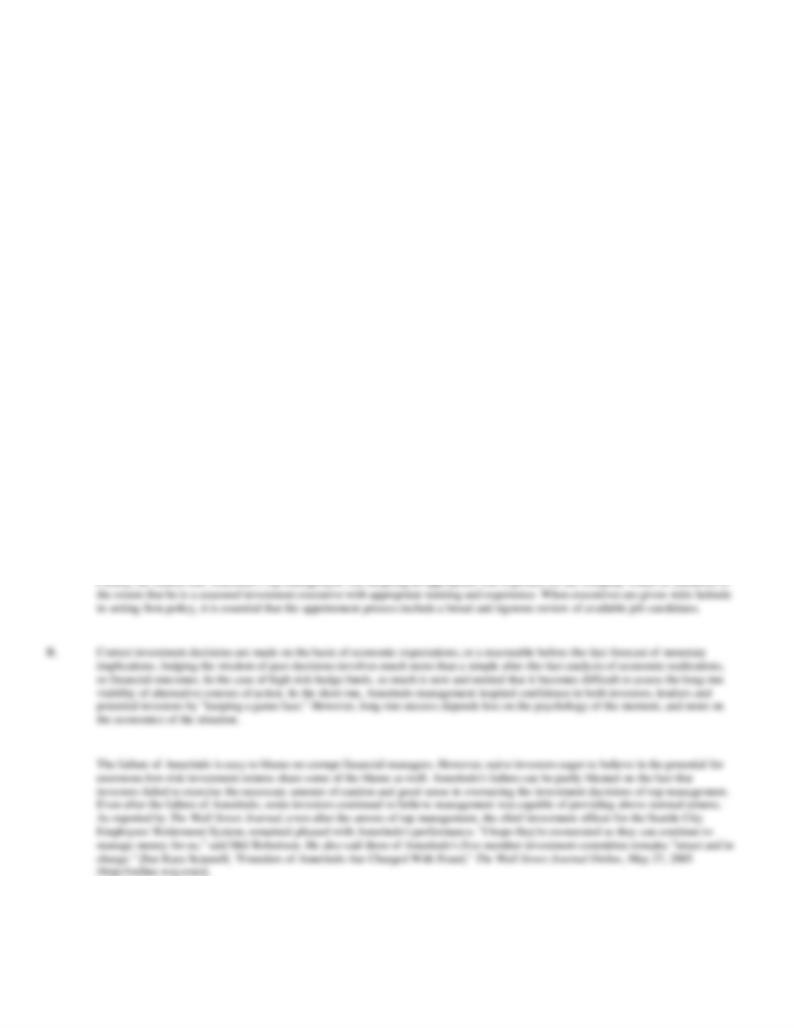
41. Excessive Risk Taking. In 2005, The Wall Street Journal reported that two founders of Amerindo
Investment Advisors Inc., a money-management firm that makes outsized bets in technology stocks, were
charged with stealing millions of dollars from investors to make charitable donations and buy thoroughbred
racehorses. Alberto Vilar and Gary Tanaka were charged with fraud and arrested by U.S. Postal inspectors.
Vilar and Tanaka made names for themselves by betting big on biotechnology and technology stocks. Their
fund was an early investor in Web portal Yahoo Inc. and generated huge returns for its early investors,
including many institutions and high net-worth individuals. The duo later created a mutual fund, which in 1999
reported a 249% return to investors.
After amassing a huge fortune in the late 1990s, Vilar pledged hundreds of millions of dollars to charities,
including New York's Metropolitan Opera, Washington's Kennedy Center and New York University. Hurt by
the bursting of the technology bubble and an exodus of investors, the firm's assets under management dropped
from $8 billion in March 2000 to about $1.5 billion in 2005.
A.
As a potential investor, what aspects of Amerindo's corporate governance system would you scrutinize to assure yourself that the firm's
risk-seeking behavior was appropriate?
B.
Explain why both Amerindo's insiders and outside investors might both share blame for this fiasco.
A.
As a potential investor, it is crucial to examine Amerindo's corporate governance system to insure that management's extremely
risk-seeking behavior was indeed appropriate. Agency problems commonly arise when there are stark owner-manager differences in
risk exposure, investment horizons and/or familiarity with investment opportunities.
How much common stock in Amerindo funds was owned by members of top management, and members of the board of directors? If
inside stock ownership is large in both dollar and percentage terms, then the probability of shareholder-friendly operating and
investment decisions is enhanced. This is particularly true if such ownership interests were obtained through open-market purchases
using the insiders own financial resources. To the extent that executive stock options bridge the gap between owners and managers, they
also can prove to be an effective device for mitigating or eliminating agency problems. Thus, an executive compensation plan that
emphasized stock options or incentive-based pay could also prove effective in ensuring an appropriate level of risk-taking behavior by
members of top management.
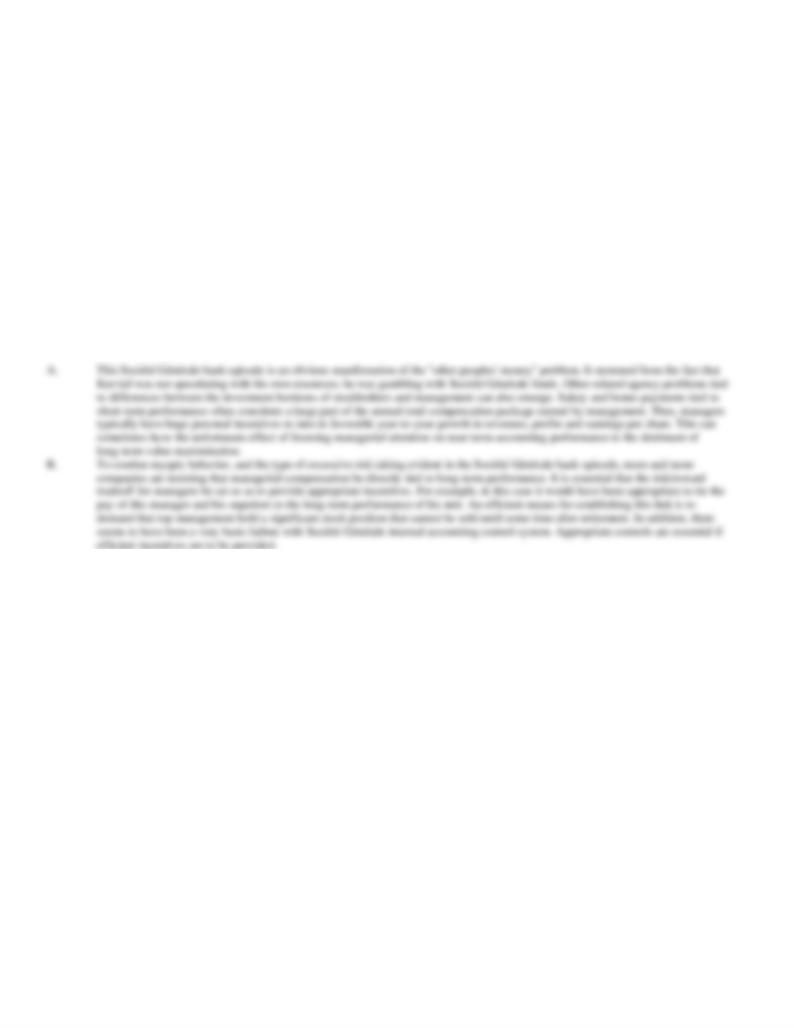
42. Other Peoples' Money Problem. In 2008, France's Société Générale SA said that a 31-year-old trader
named Jérôme Kerviel had cost the bank €4.9 billion (equivalent to $7.2 billion) by making huge unauthorized
trades. Société Générale's loss dwarfed the $1.3 billion Nick Leeson cost Britain's Barings Bank in 1995, and
forced Société Générale to seek a capital infusion of as much as €5.5 billion ($8 billion). Société Générale's loss
was only one of many huge write offs tied to a general breakdown in risk controls at gigantic international
financial institutions. In 2007-08, giant financial institutions around the world lost billions of dollars on
complex financial instruments tied to subprime mortgages and various poorly designed trading strategies. Such
losses had important and far-reaching economic ramifications. For example, Société Générale's frantic efforts to
unwind Kerviel's unauthorized trades over a 72-hour period rattled global financial markets, and spurred
dramatic moves by the Federal Reserve Board's Ben Bernanke to cut U.S. interest rates and head off a deep
economic recession.
A.
Explain this Société Générale bank episode as a manifestation of the "other peoples' money" problem.
B.
How could it have been avoided?
43. Incentive Compensation. Salary and bonus payments tied to short-term performance often constitute a
large part of the annual total compensation package earned by top management. Thus, top managers, like the
chief executive officer (CEO), typically have huge personal incentives to turn in favorable year-to-year growth
in revenues, profits and earnings per share. This can sometimes have the unfortunate effect of focusing
managerial attention on near-term accounting performance to the detriment of long-term value maximization.
A.
Explain some tools companies use to combat such myopic behavior.
B.
Explain why a stock-option plan might be very appropriate for the CEO, but inappropriate for workers in general.
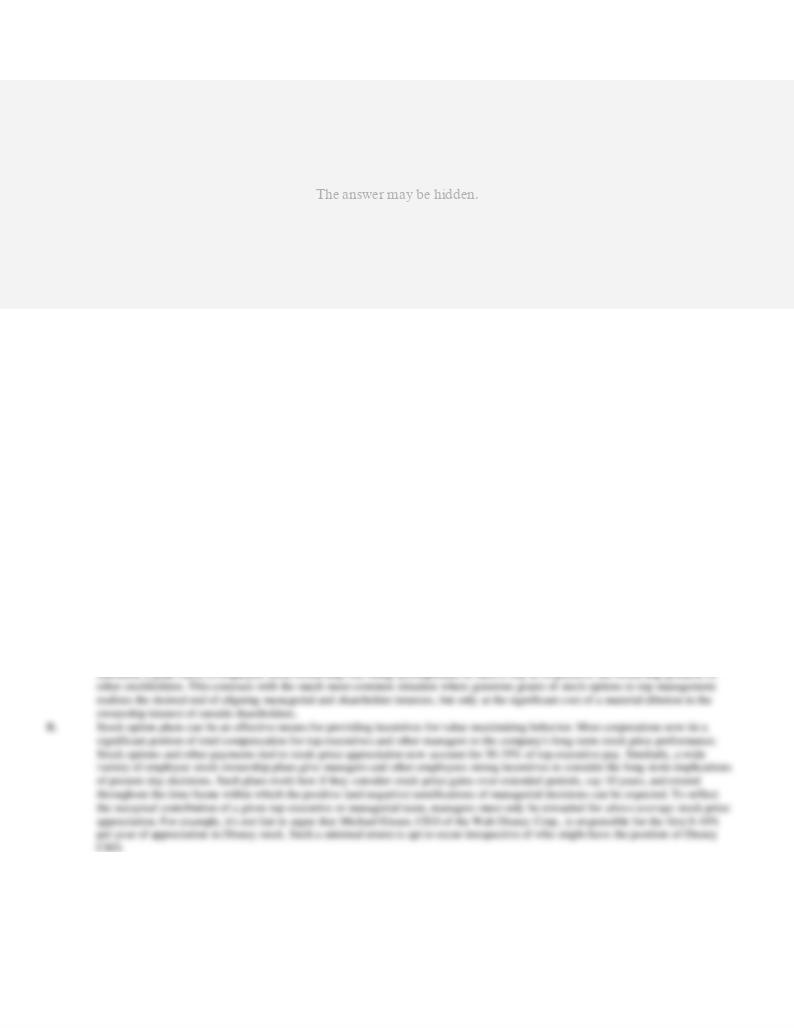
44. Incentive Compensation. Salary and bonus payments tied to short-term performance often constitute a
large part of the annual total compensation package earned by top management. Thus, top managers, like the
chief executive officer (CEO), typically have huge personal incentives to turn in favorable year-to-year growth
in revenues, profits and earnings per share. This can sometimes have the unfortunate effect of focusing
managerial attention on near-term accounting performance to the detriment of long-term value maximization.
A.
Identify some tools companies use to combat such myopic behavior.
B.
Explain the pluses and minuses of stock options versus stock ownership as effective incentive devices.
A.
To combat such myopic behavior, more and more companies are insisting that managerial compensation be directly tied to long-term
performance. An efficient means for establishing this link is to demand that top management hold a significant stock position that
cannot be sold until some time after retirement. When it was an independent entity, investment bank Salomon, Inc., established a
compensation plan whereby managers were required to take a significant portion of total compensation in the form of common stock
that could not be sold until five years after the employee left the bank. Over time, traders managing directors, top management and
other employees at Salomon came to own roughly 35% of the company. Most impressively, this significant employee ownership was
achieved through direct stock purchases in the open market; no outright grants of employee or executive stock options are involved. At
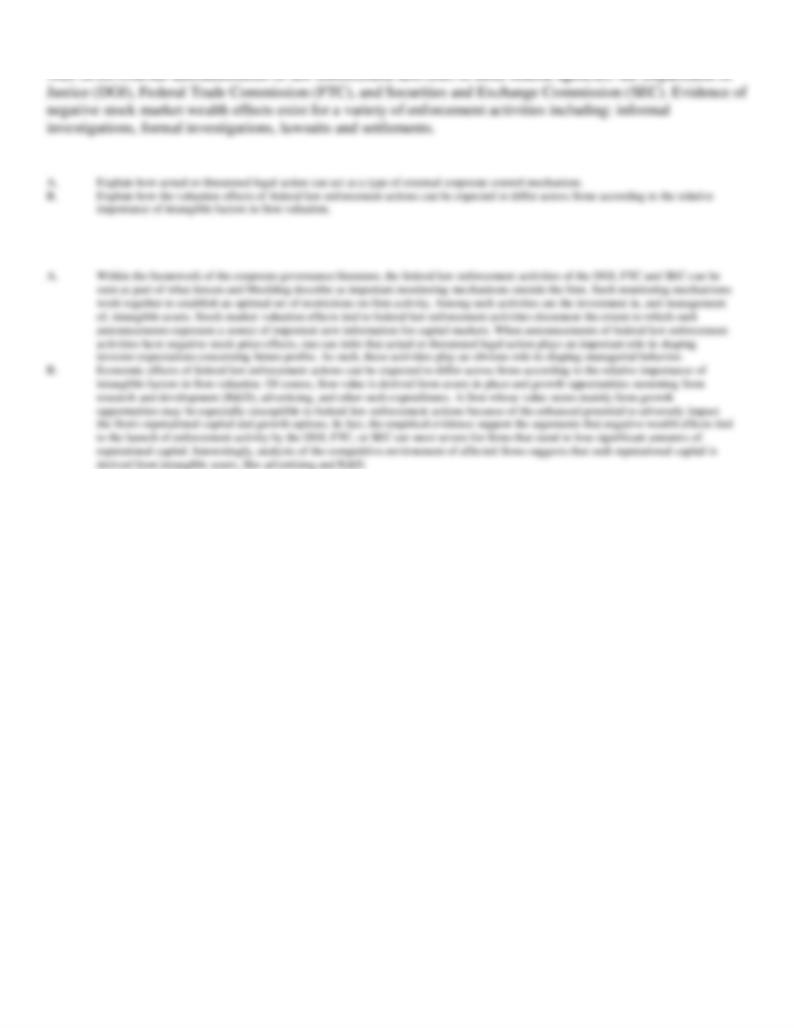
45. Corporate Governance. Empirical studies show a negative stock-price reaction for firms mentioned in
46. Corporate Governance. In a fully informed stock market, news regarding the enforcement of federal laws
against publicly traded firms would have no effect on target firm stock prices. A "rational expectations
hypothesis" predicts that investors would be unaffected by announcements concerning the enforcement actions
of federal agencies because current stock prices accurately reflect discounted future cash flows based upon all
relevant information. An absence of announcement effects tied to federal law enforcement actions would
suggest that the market is fully aware of illegal activity, the probability of getting caught, and the potential
sanctions tied to detection and conviction. Future cash flows lost following federal law enforcement actions can
include the costs of sacrificing illegal advantages over competitors, investigation expenditures, litigation
expenses, and lost reputational capital. An absence of abnormal returns tied to federal law enforcement actions
does not mean that there is no cost to being caught; it simply implies that the market correctly anticipates the
magnitude and probability of such costs. Here it is important to recognize that the term "caught" does not
necessarily imply guilt as well. Under the rational expectations hypothesis, market participants also know the
probability of innocent firms being investigated or sued.
A.
How would you interpret positive stock-price effects tied to public announcements regarding the enforcement actions of federal
agencies?
B.
Conversely, how would you interpret negative stock-price effects tied to public announcements regarding the enforcement actions of
federal agencies?
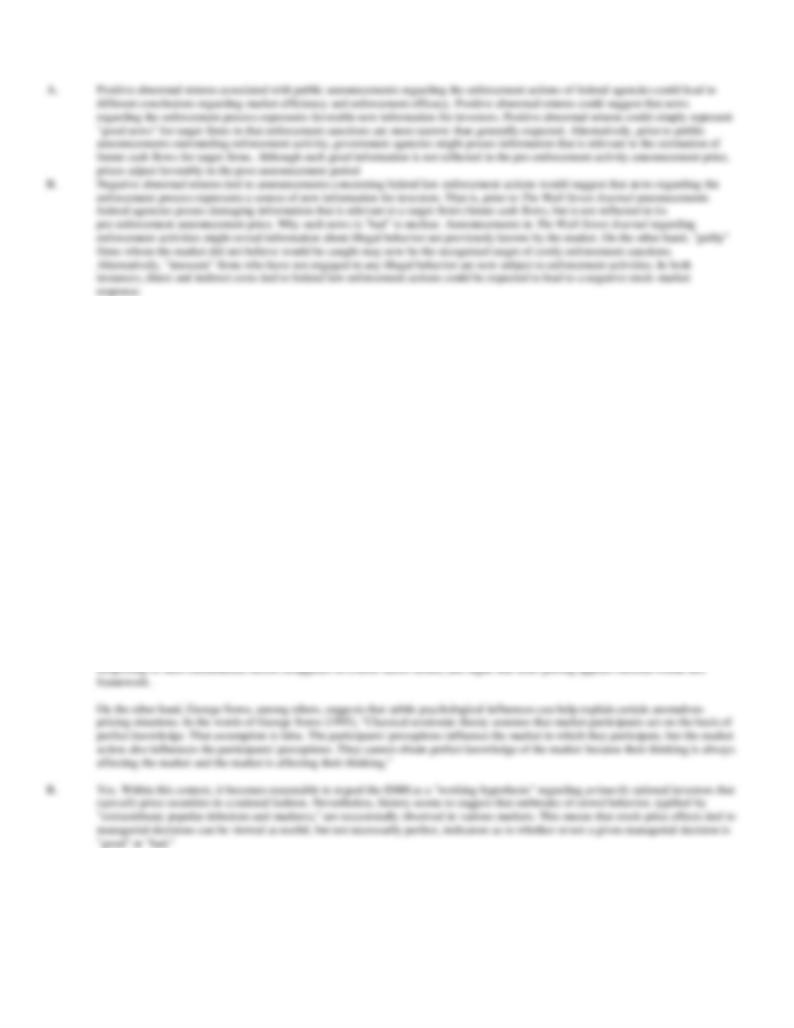
47. Stock-market Indicators of Efficiency. According to the Efficient Market Hypothesis, current stock prices
reflect all relevant risk and return information. This implies that near-term stock price changes are random and
independent. In a rational pricing environment, investing in the stock market is a "fair game" where the
expected excess return for each security is zero. Taken literally, this means that every stock at every point in
time is an equally good buy (or sell). Within this context, the stock market provides a useful context within
which to evaluate managerial decisions. "Good" decisions boost share prices, and "bad" decisions cause share
prices to fall.
A.
Does evidence of inefficiency in the stock market reduce its usefulness as an indicator of managerial efficiency?
B.
Suppose that the stock market is very efficient, but not perfectly efficient. Can stock prices still be used to provide information about
managerial efficiency?
A.
Yes. A large and growing literature on stock-market anomalies suggests that unexplained systematic abnormal returns may reflect
market inefficiency and/or more elusive errors in expected return calculation (model misspecification). Fama and French (1996), among
others, show that average returns on common stocks are related to firm characteristics like size, earning/price, high cash flow/price,
book-to-market equity, past sales growth, long-term past return, and short-term past return. Fama and French argue that the perceived
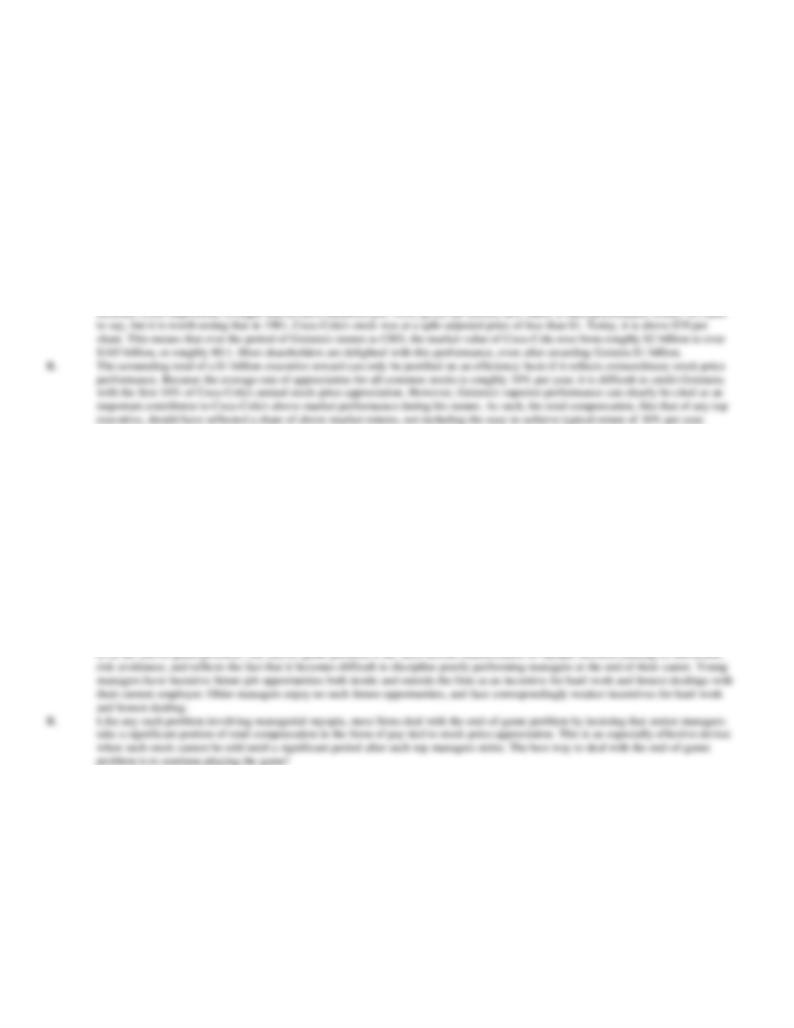
48. Executive Compensation. Roberto Goizueta did a superb job as head of soft-drink juggernaut Coca-Cola.
During the 1980s and 1990s, Goizueta set an enviable standard for CEO performance in terms of global brand
development, market share expansion, profitable asset deployment and market value creation. From when
Goizueta took charge in 1981 until his death in 1998, Coca-Cola revenues grew at roughly 8% per year,
earnings per share soared more than 16% per year, and its stock price skyrocketed a whopping 27% per year. In
light of the company's outstanding performance, one can understand why the Coca-Cola board of directors
awarded Goizeta generous salary, bonus and stock awards totaling over $1 billion dollars during his tenure.
A.
Defend the hypothesis that Roberto Goizeta's accomplishments as CEO were worth $1 billion in total compensation.
B.
Defend the hypothesis that nobody, not even Roberto Goizeta, is worth $1 billion in total compensation.
A.
Look at the record, it's easy to argue that Roberto Goizeta, and the management team he assembled, were far above average. It's
49. End-of-game Problem. One of the most vexing problems facing boards of directors and stockholders is the
so-called "end-of-game" problem.
A.
What is it?
B.
How do firms efficiently deal with such difficulties?
A.
Given the advanced age of most top executives and many senior managers, firms must be on guard against what is sometimes referred

50. Organization Design. An effective organization design is one that allocates decision authority to that
person or team of persons best able to perform a given task or influence a particular outcome. Decision
authority allows individual employees to determine how and when to best deploy the productive resources and
valuable information at their disposal. Of course, decision authority confers responsibility. It is thus imperative
to monitor and evaluate performance. Managers and all employees must be held accountable for outcomes tied
to individual decisions. Accountability can only be measured in terms of the tangible and intangible rewards
derived from productive activity, and in terms of the penalties or sanctions tied to unproductive behavior. To
minimize the costs of unproductive conflict with the firm, it is essential that the design of the organization
effectively allocate decision making authority.
A.
Describe centralized decision authority. Under what conditions does it work best?
B.
What is decentralized decision authority, and when does it work best?
A.
With centralized decision authority, detailed judgments concerning how to best manage corporate resources, deal with suppliers and
customers, and so on, are handled by top-line executives within the organization. Many corporations with a centralized, or "top-down,"
management style employ a significant central office staff. The decision to feature a centralized or decentralized management structure
is often an evolutionary process. At some companies, when the size and scale of operation grows effective resource management
requires greater centralization of decision making authority. At others, the need to remain nimble in responding to customer needs
requires ongoing employee empowerment.